“Good Good” called out the taxi driver as he eased slowly past us on a climb. “I love you” shouted a group of giggling middle-aged ladies from the side of the road. “Big fan” yelled a group of small boys from the terrace of their school which overlooked where we were taking a snack break. That sums up in a couple of sentences what riding through Nepal with a group of gravel riders feels like. If the Visit Nepal tourist board had paid people to be ambassadors for their amazing country they had done a good job, but the welcome felt genuine and heartwarming. If you’ve ever wondered what gravel riding in Nepal is like, then part one of Olly’s account from the inaugural version of the Trans-Nepal Gravel should be just what you’re looking for.
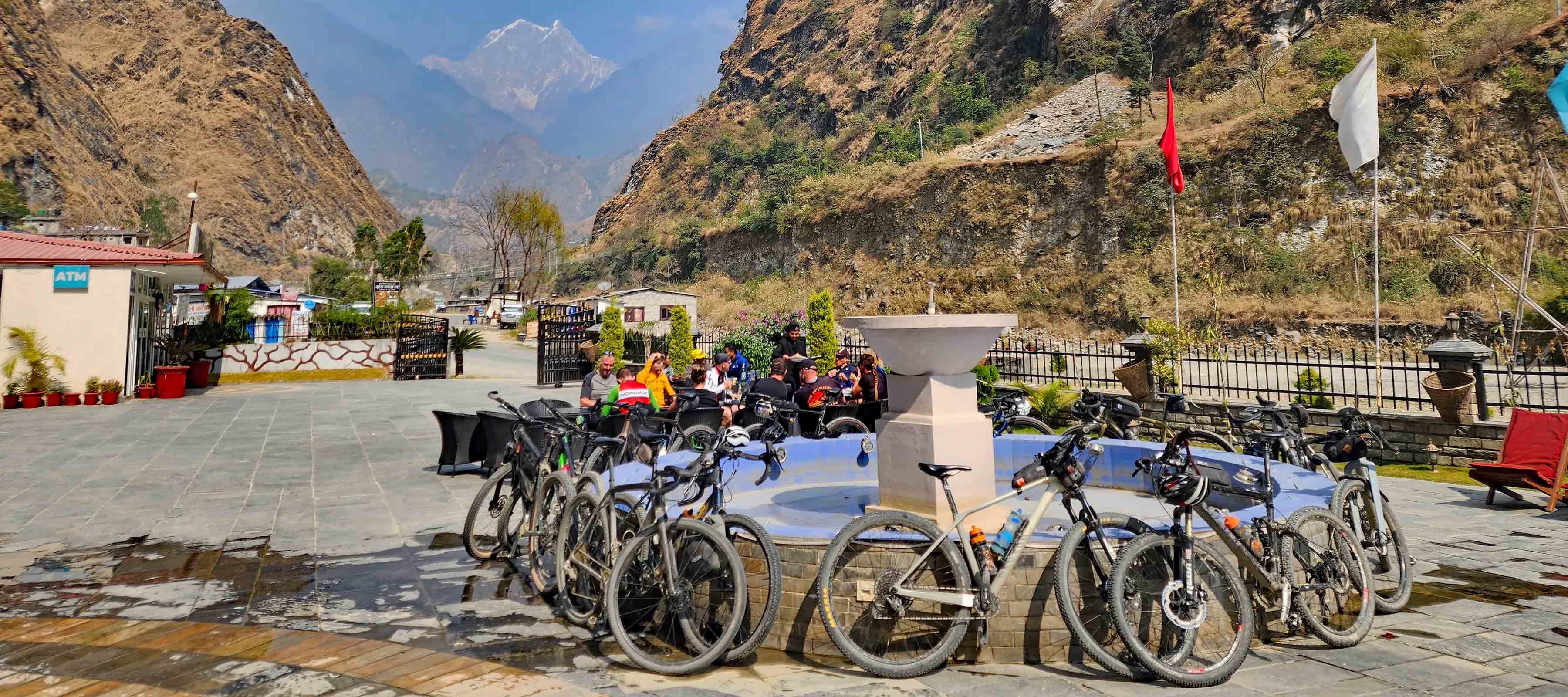
Image courtesy of Ajay Chhetri
“I should be happy as Larry, but there is a strangely empty feeling deep within my soul.”
We’re sitting in warm sunshine outside a posh hotel. Uniformed waiters are ferrying around delicious freshly cooked pizzas, chilled drinks and whatever else anyone asks for. Behind me are vast snowcapped mountains rising up into an azure sky. The air has a tropical feel to it, unusual bird sound is just audible above the noise of an occasional passing vehicle and the verdant greenery all around us confirms we are somewhere interesting. The group are buzzing and everyone looks healthy and relaxed. With the perfect combination of location, people, weather and service I should be happy as Larry, but there is a strangely empty feeling deep within my soul.
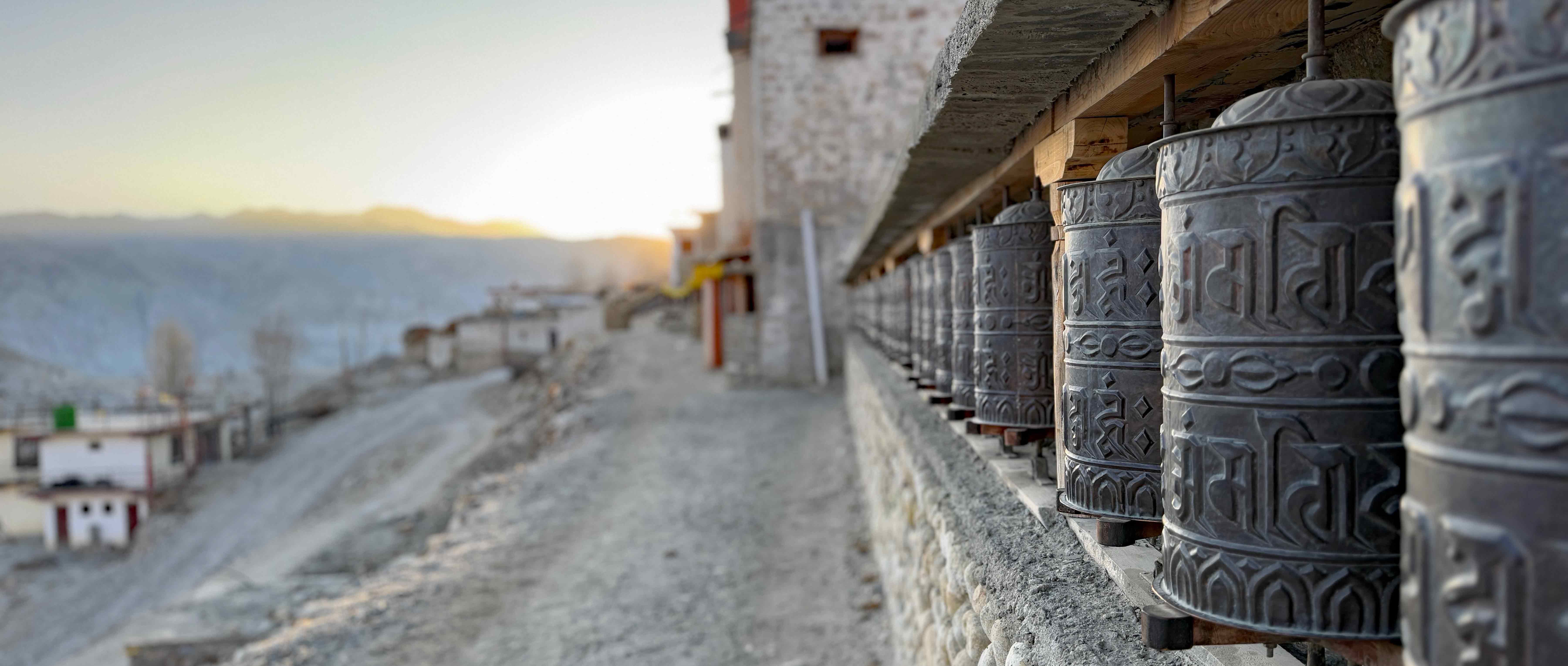
Although the thought of a hot shower and a comfy bed that the hotel promises is an enticing one, every sinew in my body instead wants to be back at 4000m, staying at a freezing cold and not-entirely-palatial hotel in the mind-blowing city of Lo Monthang. We were only there for just over 24 hours, but it has engrained itself into my soul in a way that I wasn’t expecting. It is like nowhere that I’ve ever been before, but which also somehow felt familiar. The city itself is tiny, with only 120 households registered there in the last Nepali census. This incredible place is the official start point for our trip, or at least, it’s the closest place where we can find overnight accommodation. The actual start point is 30 minutes drive on a bumpy dirt track further to the north. We had hoped to actually start at the Nepali/Tibetan border at Korala, but overly officious Chinese authorities unfortunately refused us permission to start at the border itself, so we started as far north as we could instead.
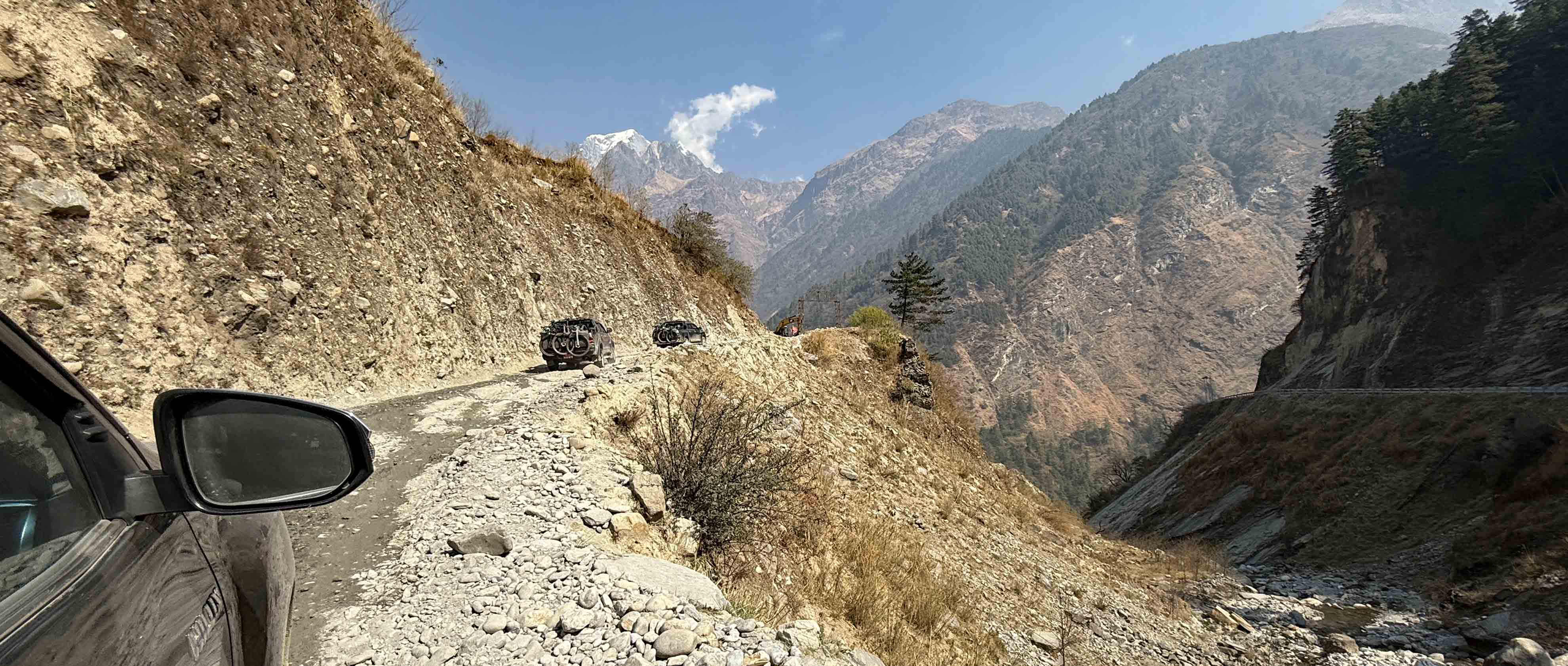
Signing up for an event which requires four days travel just to get to the start point (and that’s from the Nepali capital Kathmandu, not from wherever your home is) takes some serious commitment. It probably both limits the appeal of the event to a wider audience but also means that anyone who does decide to join the event (hopefully) has just the right mix of energy, determination and craziness required to thrive in such a remote (and at times inhospitable) location.
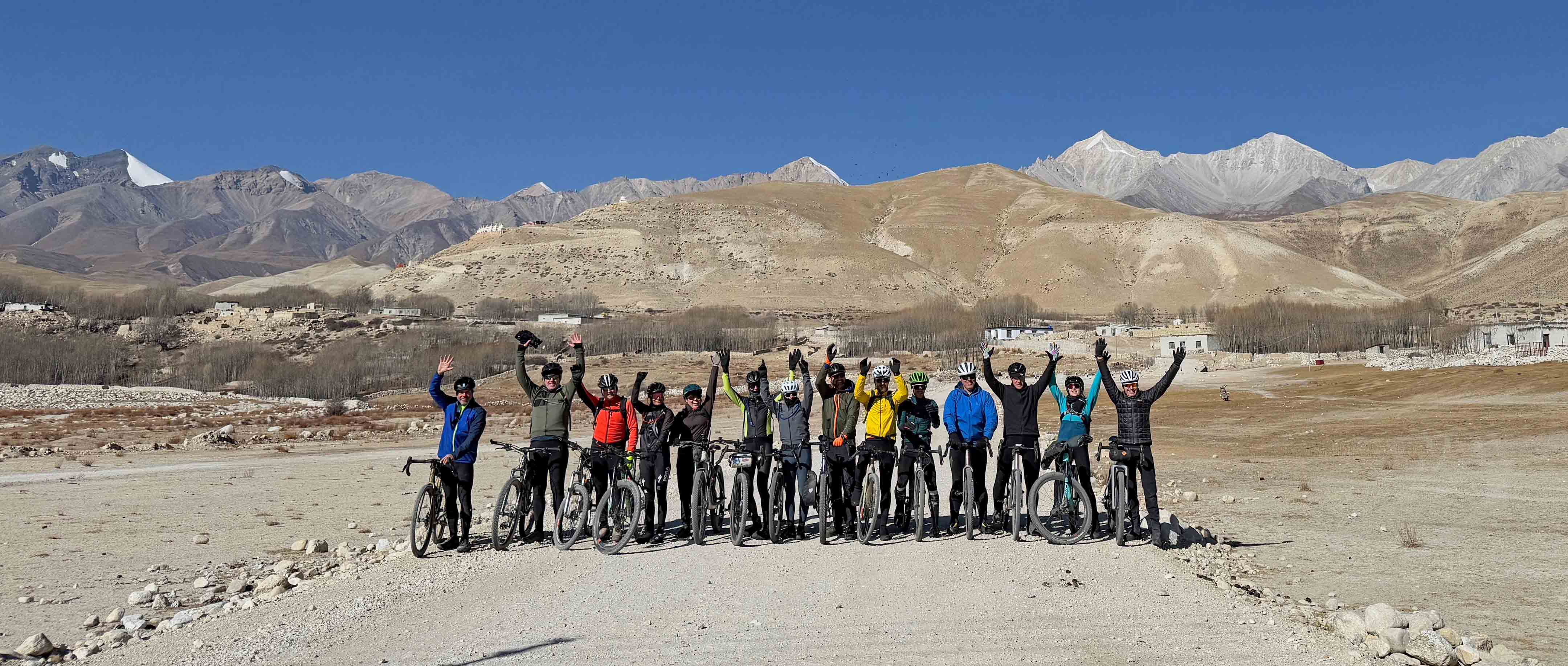
For the inaugural Trans-Nepal Gravel event, twelve intrepid riders had signed up. As soon as I heard the event was going to be starting in the Kingdom of Mustang, I practically begged organiser Phil Evans to let me come and join the fun. I convinced him that my previous experience of cycling and trekking at altitude in some interesting parts of the world meant I wouldn’t be a liability to the trip and fortunately he agreed to let me join. Nine months later, my training was done, my bags were packed, my bike was prepped and my flight landed in Kathmandu, where I headed to the start hotel to meet the rest of the riders and the Nepali team who would be looking after us.
“Getting some extra acclimatisation miles in before getting to the start proper seemed like a prudent move.”
Although officially the Trans-Nepal event only comprises six days of riding, participants are given the opportunity for extra riding on the ‘transfer’ days up to the start point. With our start point being located at just over 4000m, getting some extra acclimatisation miles in before getting to the start proper seemed like a prudent move. Also, if you had a choice to do some extra gravel riding in a landscape as stunning as this, why would you choose to just sit inside one our fleet of four-wheel drive jeeps instead?
In order to reduce driving time to a minimum, the initial plan had been for the group to take an early morning flight from the lakeside resort town of Pokhara up to the mountain town of Jomsom. However, in the run up to the event, the event organisers discovered that the mountain flight would not be taking place due to lack of demand and that even chartering our own plane would not be possible. Instead, we switched to Plan B – the group would fly from Kathmandu to Pokhara and then drive up into the mountains. While we had the relative ease of a short transfer to the airport, followed by an equally short but significantly more scenic flight to Pokhara, our support crew had to load up our bikes, luggage and all the miscellaneous support equipment that we would need before setting off for the day-long drive to Pokhara.
“The road surface deteriorated into a jumble of loosely compacted rock, dust and mud.”
After a first ‘team dinner’ in Pokhara, we set off early next morning in our jeeps, bound for our overnight accommodation in Kagbeni, an ancient village which lay right on the border of Upper Mustang. Knowing that we would have three more travelling days ahead of us, we made the most of it and spent the time getting to know our fellow passengers and support crew. Our initial route was on smooth paved roads, but in places it seemed like engineering armageddon had arrived and the road surface deteriorated into a jumble of loosely compacted rock, dust and mud. Vast chasms which had been created by monsoon rains and landslides were evident and road mending crews were valiantly attempting to wrestle some order from the chaos. Despite the occasionally rough surface, our drivers did an incredible job and we seemed to arrive surprisingly quicky at our lunchtime destination of Tukuche.
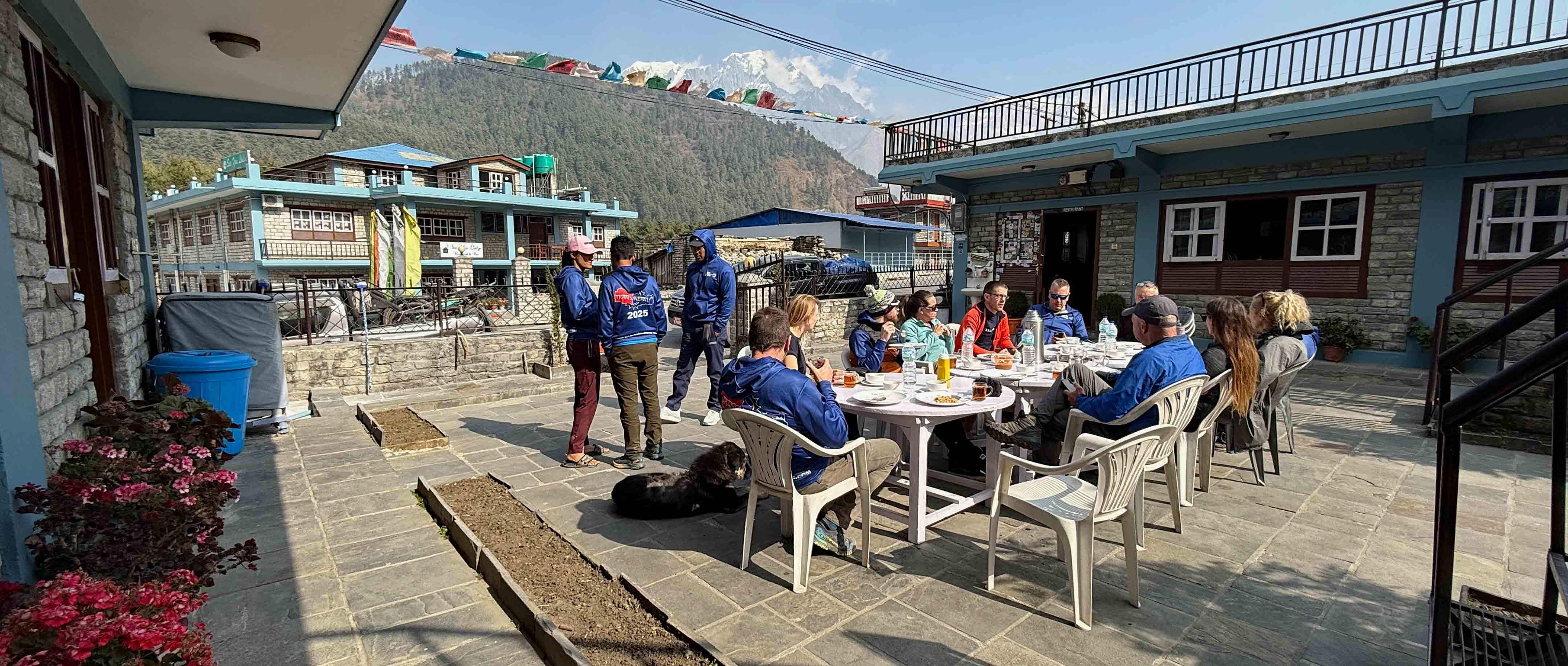
With a stunning backdrop of snowcapped mountains, we ate lunch outside in the courtyard of a small hotel. A pattern which we were witness repeatedly over the next few weeks became immediately obvious – our lead guide Usha, Nepal’s 2023 women’s XC and DH MTB champion, effortlessly took control of operations and bowls of steaming garlic soup were soon followed by plates heaped high with delicious rice and veg. As we had driven up into the mountains that morning, we had left behind the impenetrable low-level murk of Pokhara which had sadly obscured the normally stunning view from there. Here in Tukuche however, the skies were blue and warm sunshine beat down on the courtyard. Even just walking around however it was pretty obvious that we were dramatically higher than our starting altitude and if you ventured into the shadows, the temperature dropped sharply.
With lunch finished, we were given the opportunity to ride the remaining 20 km to our overnight accommodation. After a long morning spent sitting inside a vehicle, everyone jumped at the chance and so our bikes and kit bags were unpacked from the jeeps. The hotel owners allowed everyone to use some unoccupied rooms to get changed in and it wasn’t long before we were saddled up and ready to hit the road. Our route was planned as an ideal gentle introduction to riding at altitude and the initial section was on tarmac. With Usha setting a perfect pace, our mini-peloton rode northwards, bound for the Upper Mustang border.
As we made our way up the valley, waves of golden light washed across the Kali Gandaki river valley as we approached Kagbeni. The intensity of the colours and the length of the shadows was a photographer’s dream. If this was what the first day’s ride had in store for us, it was hopefully a good omen for the rest of the trip.
“It was immediately obvious just how much height we had already gained.”
Our first night in the mountains set the bar high – YacDonalds is a fantastically well-equipped teahouse set in the very centre of the ancient trading village of Kagbeni. Delicious food (including freshly made apple crumble, with apples grown on the fertile valley terraces on the outskirts of the village), comfy beds and hot showers proved to be a winning start to the high-altitude section of our trip. When we set off from Pokhara that morning, our starting altitude was a lowly 820m, but by the time we arrived in Kagbeni, we had climbed more than 2000m and it was noticeable! Carrying a heavy kit bag up the steep, timeworn staircase to our rooms, it was immediately obvious just how much height we had already gained.
Day Three of our transfer journey saw us head ever-higher into the mountains and closer to our goal of Lo Monthang. At the evening briefing we were given a choice of how much (or how little) riding we would like to do the following day. A small cadre of riders decided to go all-in and ride the whole of the 56km route to our next overnight stop in Ghami. At sea level, a ride like this would be pretty insignificant, but the route parcours included a total of nearly 2000m of climbing and riders would touch the magic 4000m point on two occasions. I decided it was a little too soon for such a big day of high altitude, so spent the morning in the lead jeep hopping in and out to try and capture images and video of the incredible scenery.
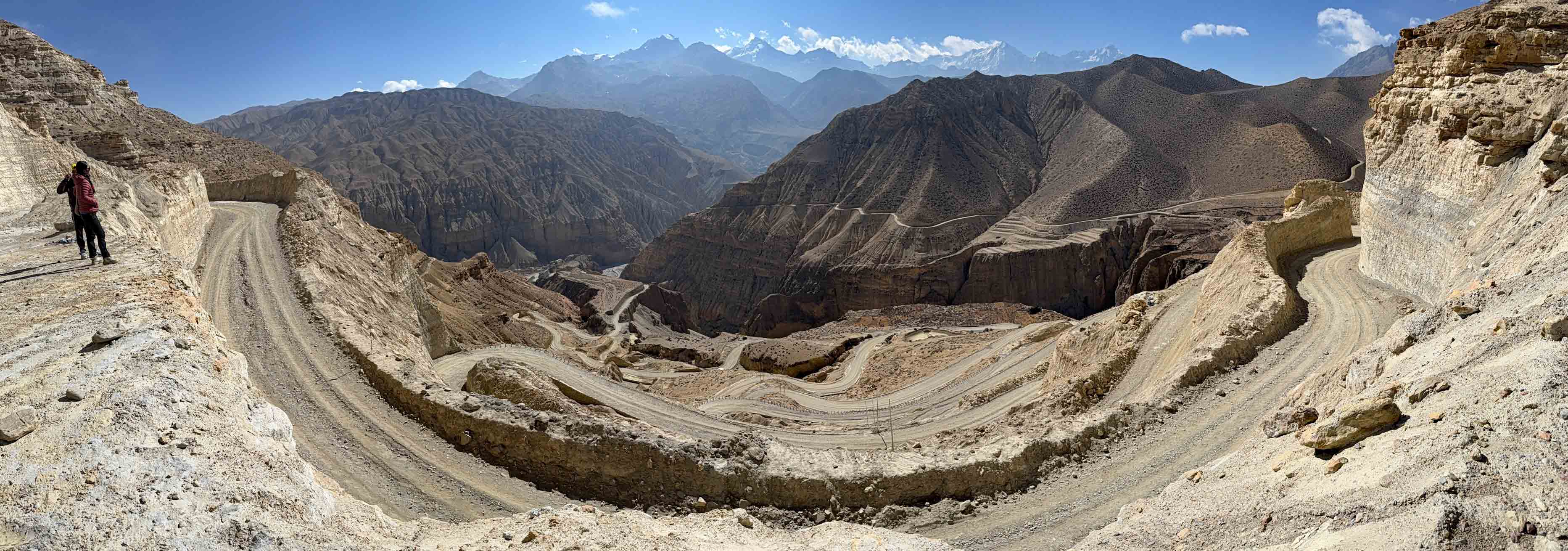
Something that takes a little while to get used to when travelling in Upper Mustang is the scale of the mountains. The riders who chose to complete the entire route would climb for the almost the whole of the first 35 km! The engineering that had gone into building the track between Kagbeni and Lo Monthang (and eventually onto the Tibetan border) was also pretty incredible – in places hairpin after hairpin had been carved out of the limestone, sandstone and shale that characterise the geology in this region of Nepal. In an area so prone to earth tremors, sporadic monsoon downpours and extremes of temperature, it was testament to the engineers’ skills that the route was navigable at all, let alone the fact it was in decent condition.
“Even at the high point of today’s ride, we were still going to be way less than half the height of climbers attempting to summit Mount Everest.”
The portion of the group that had decided to take on a shorter version of today’s ride were driven up to an incredibly scenic drop-off point at Samar, located at 3600m. I swapped my civvies for cycling kit and mounted up to join the rest of the team. We set off in small groups, a 10 km climb up to a high pass at just under 4000m our first goal. After just a few minutes, a couple of key points became obvious – the surface of the track was far looser and rockier than we had experienced so far; despite the altitude, once you were riding it was warmer than it initially felt and finally, the altitude made it stupidly hard just to pedal! I felt like my brain had been trapped inside the body of someone double my age. Each time I tried to up my pace, the sound of my rasping breathing and the rushing of blood in my ears was quite extraordinary. As I pedalled inexorably upwards, I kept reminder myself that even at the high point of today’s ride, we were still going to be way less than half the height of climbers attempting to summit Mount Everest (or any other of the world’s tallest 8000m peaks). It was a salutary lesson in taking things slowly and was humbling in the extreme just how hard it was to keep moving forwards. Fortunately, I had an excuse to keep stopping in that I needed to try and capture some good images from the climb, but even with these regular ‘rests’, the climb was still way harder than I had anticipated.
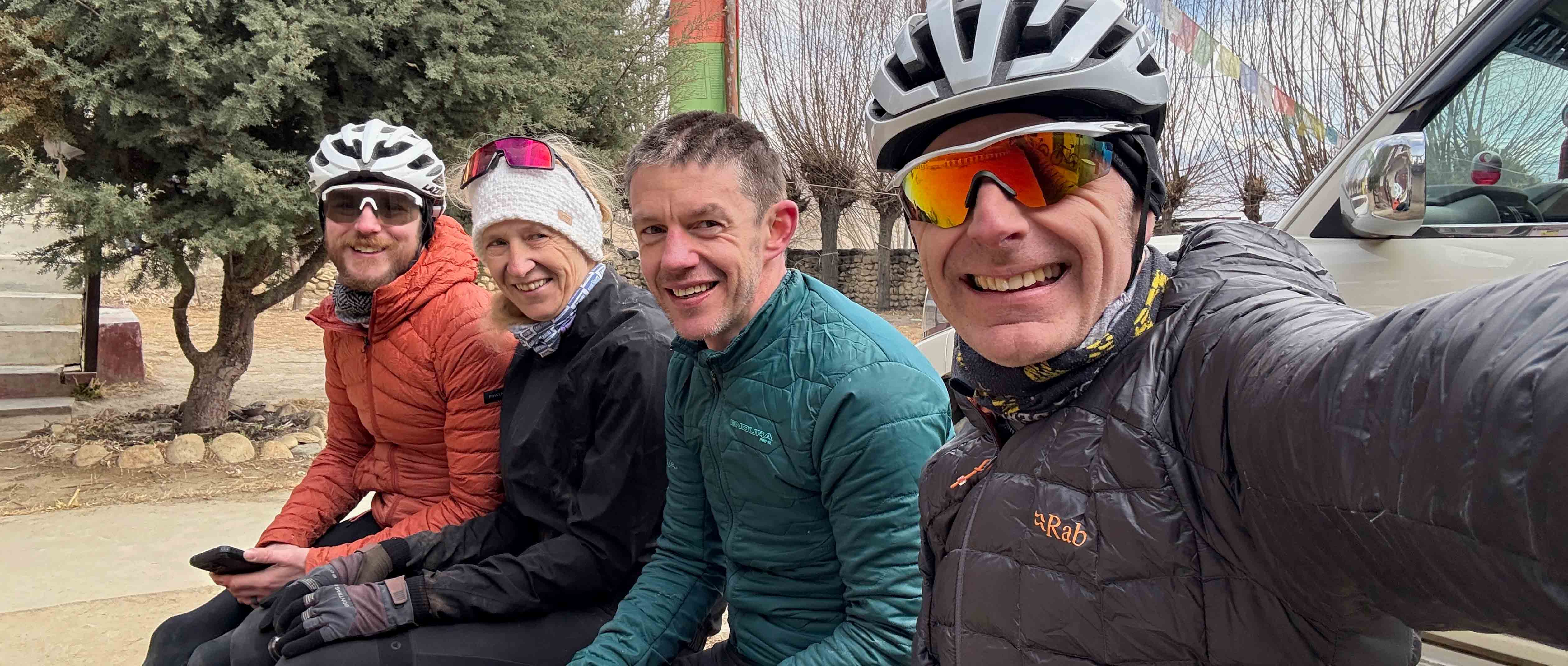
Even those of us who chose the shorter option still rode 24 km and it would be fair to say that we were pretty cooked by the time we rolled into Ghami. What none of us had really anticipated was how tough the downhills would be. The track that had been cut into the mountain side had initially been smooth graded, but heavy monsoon rains had washed the finer top layer away and what was left was pretty bone shaking. Even with my big volume tyres, the constant juddering was hard work and everyone ran significantly lower tyre pressures on subsequent days.
Practically before we had even stepped off our bikes, our incredible support crew were there proffering mugs of hot sweet black tea – something I would avoid like the plague back home, but which were the perfect welcome after a hard ride. Soon after, our incredible cook had rustled up steaming bowls of veg noodle soup and we sat on long benches in the kitchen of the teahouse (the warmest place to be), we bonded over loud appreciative slurps and celebrated the arrival of the riders who had endured the longer route option. Outside the incredible support team were hard at work and those who wanted it could have their bikes cleaned, lubed and maintained for a remarkably reasonable fee.
“Our support crew placed padded blankets over the bonnets of their jeeps to try and insulate them from the low temperatures.”
Day Four of our journey to the start saw us wake up to the now traditional cloudless skies and wall-to-wall sunshine. Despite the fact it had been well below zero overnight, so cold in fact that our support crew placed padded blankets over the bonnets of their jeeps to try and insulate them from the low temperatures, it was surprising how quickly you warm up with a bowl of hot porridge and some freshly made apple pancakes as your breakfast. Usha and her team earned their 5* rating before we had even set out pedalling – the stairs at the tea house were phenomenally steep and they smilingly delivered all the different breakfast orders without looking at all perturbed or out of breath – not something the group could replicate!
Our final transfer day would see us heading to Lo Monthang, the ancient capital of the Kingdom of Mustang. After the exertions of Day Three, we were offered a slightly cut-down riding route and everyone opted to be transferred to the top of the first climb. Some of the party, myself included, decided to have a day completely away from the bikes, but a hardy group still set out and spent the majority of the ride above 3500m, with one pass again topping out at 4000m. Part way through the day, the cyclists and non-cyclists diverted slightly off the route to visit the incredible Buddhist monastery of Lo Ghekar, which dated back to the 8th Century. The air of tranquillity which surrounded the monastery was palpable and no matter what your religious beliefs were, it was hard not to be impressed by the heritage of this incredible structure.
" Flushing the toilet meant judiciously using a jugful of water taken from a large trough of water.”
A relatively short day and some faster rolling terrain meant we arrived into the fabled city of Lo Monthang in time for lunch. First impressions were that the city was just as stunning as the photographs of it that I had seen previously, but also that it was deathly quiet. Usha explained that the fact we were there in winter meant the nighttime temperatures were likely to drop below -20 degrees C and for many of the residents that was too cold to live comfortably. Many of them with the financial means to do so generally moved out of the city and down to lower and warmer climes until the spring came back around and with it, the annual influx of tourists. In the sunshine, the temperature was surprisingly pleasant, but it was also obvious that we were above 3800m and there were some impressive ice patches hiding in the north-facing shadows. The really noticeable factor was how dry the air was. Back home, if the temperature dropped to -20 degrees C, I would hide under my duvet and not come out until spring, but in Upper Mustang the incredibly dry nature of the area meant it felt entirely different. Unfortunately, the low overnight temperatures meant there was no running water in our hotel, so even flushing the toilet meant judiciously using a jugful of water taken from a large trough of water and showers were out of the question. Wet wipes are your friend if you ever decide to come gravel riding in Upper Mustang in winter!
With another delicious lunch quickly dispatched, we were offered an optional outing to visit some of the interesting local sites. First on our list was the Zhong caves, which are believed to date back as far as 1000 BC and have been used as burial chambers, housing and places of meditation at different points through history. Unfettered by restrictive Western health & safety legislation, our female guide, who came from one of the nearby villages, was able to lead us up a series of impressively rickety ladders and through the rabbit’s warren of chambers which formed part of the five-story cave collection at this location. Next was the Lowo Nyiphug Namdrol Norbuling Sun Cave Monastery, the slightly convoluted name of which was probably created by the first person to reach the top of the steeply inclined set of steps up to the front door….
For many of us though, the highlight of the afternoon wasn’t too be found at the other end of a short jeep ride away though, it lay just outside the door of our hotel. The fabled city of Lo Monthang far exceeded my expectations – it was like walking through ancient history. Stone flagged streets polished by years of hoof prints and footsteps. Ancient white-washed buildings straight out of a painting by Robert Powell. Piles of beautifully engraved mani stones left at sacred places. The sound of innumerable prayer flags fluttering in the late evening breeze. The scent of regular piles of animal dung gathered and left to dry for fuel. The faint hum of life from behind a firmly closed low wooden door. The ever-present tinkle of bells around the necks of cattle, sheep and goats kept inside the city walls for safe keeping during the long nights.
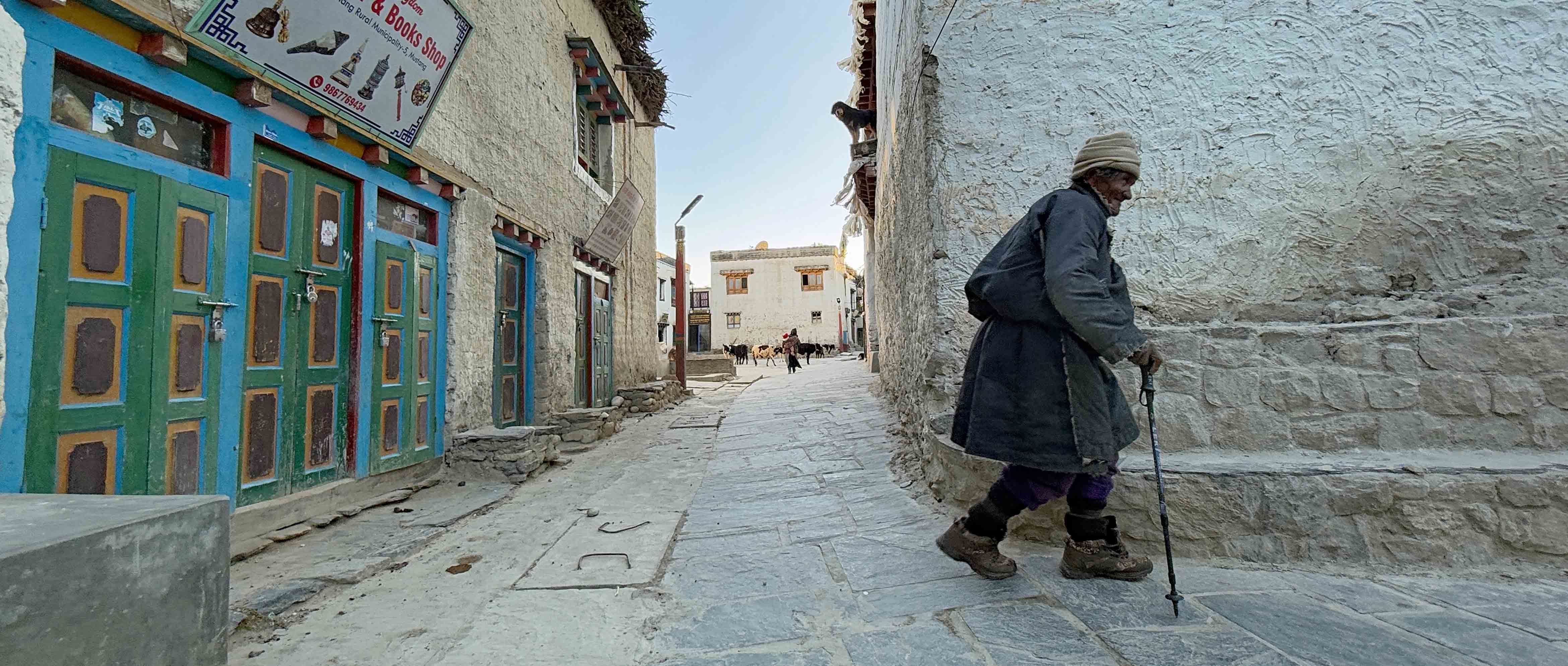
Exploring the maze of centuries old narrow streets which can be found within the imposing city walls was an incredible way to finish the afternoon and to neatly bookend the “just-getting-to-the-start-point” section of our adventure. I could have happily spent days exploring Lo Monthang and if I had any regrets from our trip, it’s only that we didn’t have longer in this incredible location.
It’s the end of Day Four of our amazing gravel traverse of Nepal and we’ve not quite got to the start point! In Part Two of the adventure, we’ll ride from the roof of Nepal down to the tropical flatlands in the far south. Along the way there will be vast descents, never-ending climbs, swaying suspension bridges, landslides to traverse, conversations with passengers on the top of busses, races with TukTuks and the first hot shower for four days, but all that is for another time…..